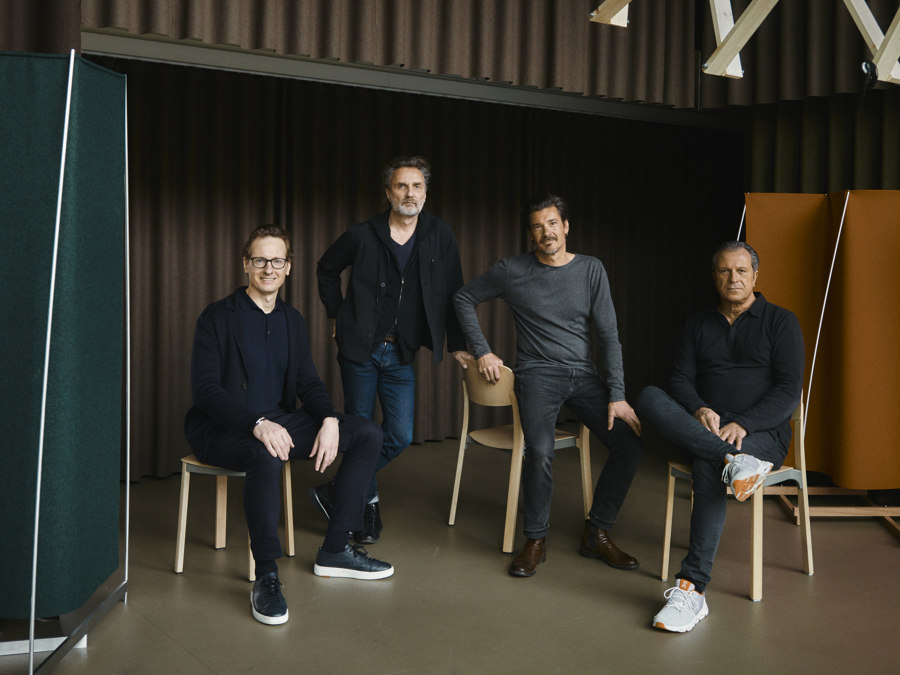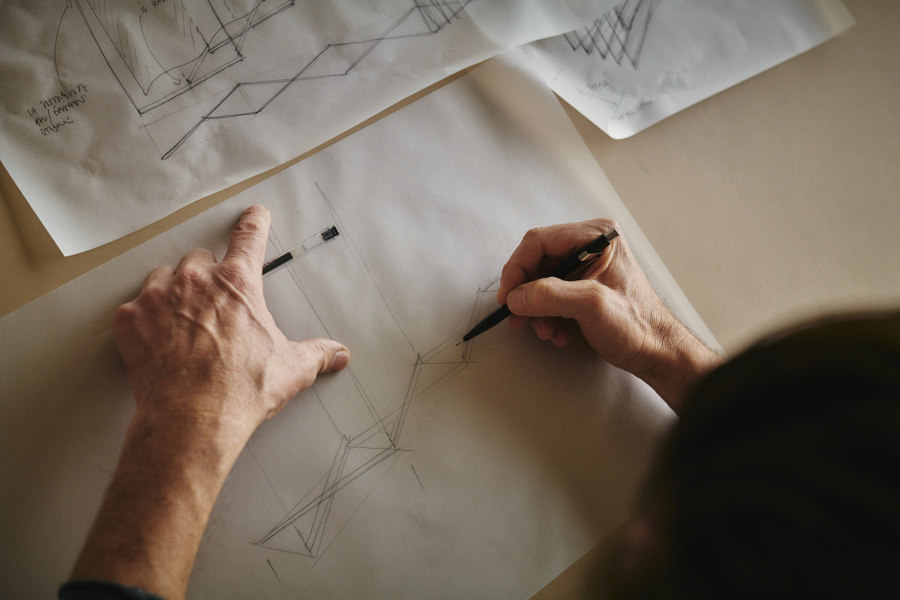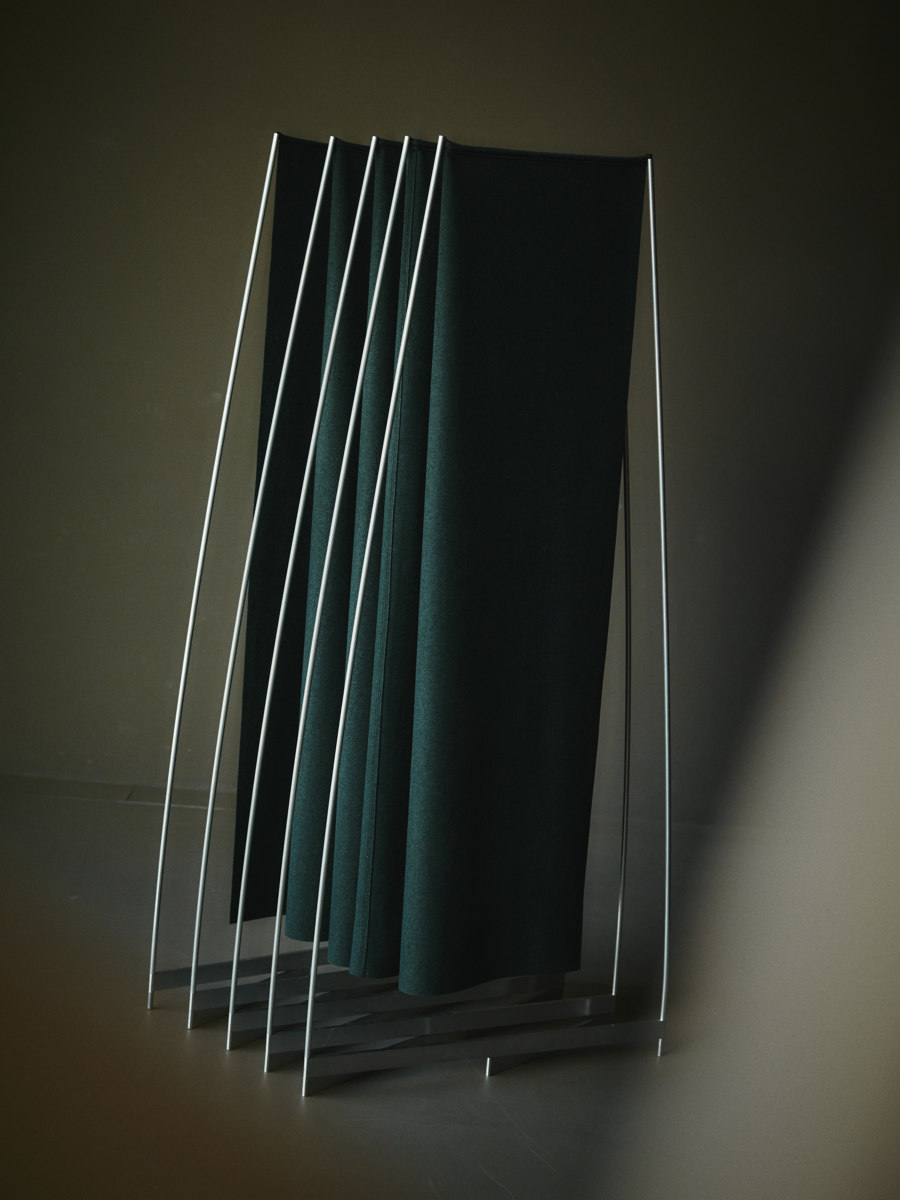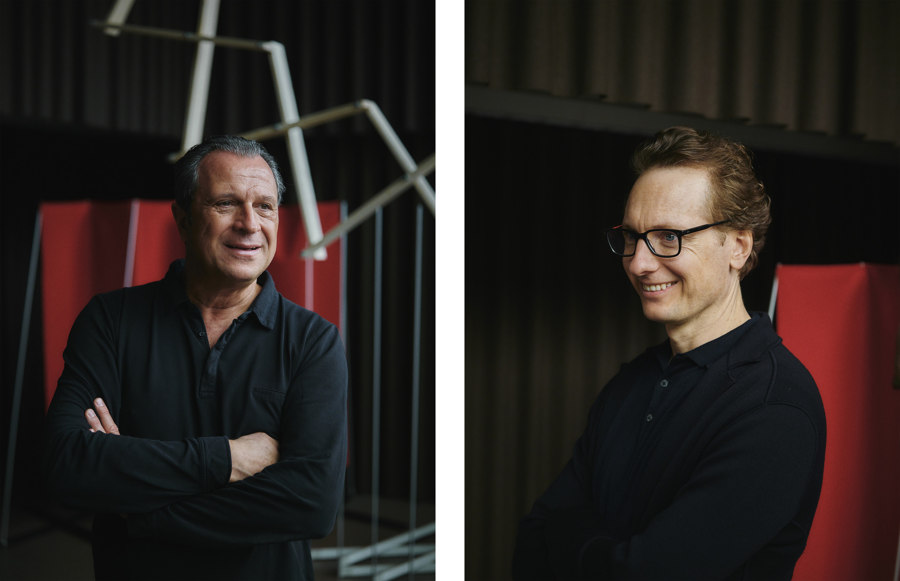Unfolding new spaces: Brunner teams up with atelier oï
Brand story von Simon Keane-Cowell
Rheinau-Freistett, Deutschland
14.04.23
Designed by Swiss creative office atelier oï for contract-furniture specialists Brunner, "foild" is an ultra-nomadic, space-shaping device that turns its users into interior planners. Text by Simon Keane-Cowell
(From left to right) Dr. Marc Brunner together with Patrick Reymond, Armand Louis and Aurel Aebi from Studio atelier oï

(From left to right) Dr. Marc Brunner together with Patrick Reymond, Armand Louis and Aurel Aebi from Studio atelier oï
×Google Maps is lying to me.
I’m making my way, on foot, from the local train station to Swiss architecture and design trio atelier oï’s office on Lake Biel in what should be, according to my phone, a mere five-minute walk. But it’s been a good quarter of an hour already and in that time I’ve been confronted with a dead-end, have clambered over a small fence, and darted through a children’s playground.
foild is the result of the first collaboration between Brunner and atelier oï, in which the approach to design was also a completely new one for Brunner

foild is the result of the first collaboration between Brunner and atelier oï, in which the approach to design was also a completely new one for Brunner
דI don’t know why the app suggests that circuitous route," says one of the team, all smiles and sympathy, when I arrive at my destination. “The road less-travelled,” I reply, thinking how apt a metaphor it is for a transdisciplinary outfit that’s spent over three decades experimenting, challenging the received boundaries of material, form and, indeed, typology. Unsurprisingly, the building itself is a major typology-bender. A cleverly adapted landmark motel from the late 1950s, atelier oï’s three-storey “Moïtel” (see what they did there?) is home to 900 square metres of workshops, offices, a materials library and a photographic studio, as well as a dedicated gallery space.
'The classic architect is interested in the stable, the static. But we are always fascinated by the dynamic'
'We’re always fascinated by the mobile, the living, in all our projects,' explains Aurel Aebi, who along with Armand Louis and Patrick Reymond, founded atelier oï in 1991. 'The classic architect is interested in the stable, the static. But we are always fascinated by the dynamic.' Their latest product-design collaboration – with Made-in-Germany, contract-furniture specialists Brunner – is no exception. Called “foild”, it is, as Aebi puts it, 'a loose piece of furniture that allows you to fold and unfold a space'; in short, a soft and optically light, ultra-flexible spatial element that, in an instant, can be deployed by the users of a space to shape it according to their individual needs.
The optically light, ultra-flexible room element foild can be used in the blink of an eye without any preparatory work and designed according to individual requirements

The optically light, ultra-flexible room element foild can be used in the blink of an eye without any preparatory work and designed according to individual requirements
×'It’s like a punctuation mark. The beauty of punctuation marks is that you can structure a sentence that is too long with them. You can add brackets, you can make a hyphen, you can put a full stop. So it's actually punctuation in a macro space, which can be endlessly moved and varied.' In other words, the user becomes a kind of ad-hoc spatial planner. Or, to use Aebi’s analogy, an editor.
Aurel Aebi (left) founded atelier oï in 1991 together with Armand Louis and Patrick Reymond. Dr. Marc Brunner (right) has led the second-generation family business – the Brunner Group – since 2004

Aurel Aebi (left) founded atelier oï in 1991 together with Armand Louis and Patrick Reymond. Dr. Marc Brunner (right) has led the second-generation family business – the Brunner Group – since 2004
×The result of a completely open brief from Brunner ('We’ve never worked with a designer this way before, but we had complete confidence in the collaboration,' says owner Dr. Marc Brunner), foild sees a horizontally expandable, skeletal structure – featuring a lattice-like, concertina base and a series of vertical aluminium rods – married with high-quality textiles that are held in tension like the sails of a boat, but ones which fold into themselves beautifully when the frame is collapsed.
'The product has such a universal character, that we can imagine it being used in the most diverse of contexts'
Unlike some of the heavy space-dividing, micro-architectural products already on the market, there’s a lightness here – both literal and visual, aesthetic and practical – meaning foild lends itself to frequent repositioning, like an ever-nomadic tent. Areas within a larger space can be defined with ease, as well as privacy delivered, shade provided, and so on. 'The product has such a universal character,' explains Dr. Marc Brunner, 'that we can imagine it being used in the most diverse of contexts. For example, when it comes to creating structures within public areas, at events, guidance systems perhaps or simply to conceal things for certain moments in the area. Especially seminar settings, where agile working groups can create pop-up spaces. And all of this with a product that uses as little material as possible. This was extremely important to us.'
The development of foild also focused on the sustainable aspect, such as the easy disassembly of parts at the end of life for easy refurbishment, reuse or recycling

The development of foild also focused on the sustainable aspect, such as the easy disassembly of parts at the end of life for easy refurbishment, reuse or recycling
×For Aebi, atelier oï’s extensive ‘savoir-faire’, its deep know-how that combines a solid understanding of engineering with an extreme fascination with materials and craftsmanship, is what underpins foild’s success. 'We think with our hands,' he says, emphasising the intense, iterative process of physical prototyping and refinement that goes into the studio’s approach to product development.
But it’s also this all-hands-on modus operandi that serves to deliver more sustainable products, with foild a prime example. Here, not only has the amount of materials used been limited; they have also been joined in such a way as to allow easy disassembly of the product’s constituent parts at end of life, ready for refurbishment, reuse or recycling, ready to be folded back into the manufacturing ecosystem. Or should that be foilded?
foild is a space-shaping device that is suitable for use in a wide variety of contexts – and particularly good for constant repositioning

foild is a space-shaping device that is suitable for use in a wide variety of contexts – and particularly good for constant repositioning
×17. bis 23. April 2023
Via Marco Formentini 10 / Brera Design District
10 bis 20 Uhr
Brunner x atelier oï = foild: Erfahren Sie mehr über die erste Designkooperation der beiden Marken im Video
Fotos © Brunner / atelier oï
© Architonic
Im Architonic Magazin finden Sie weitere Einblicke über die neuesten Produkte, Trends und Praktiken in Architektur und Design.








